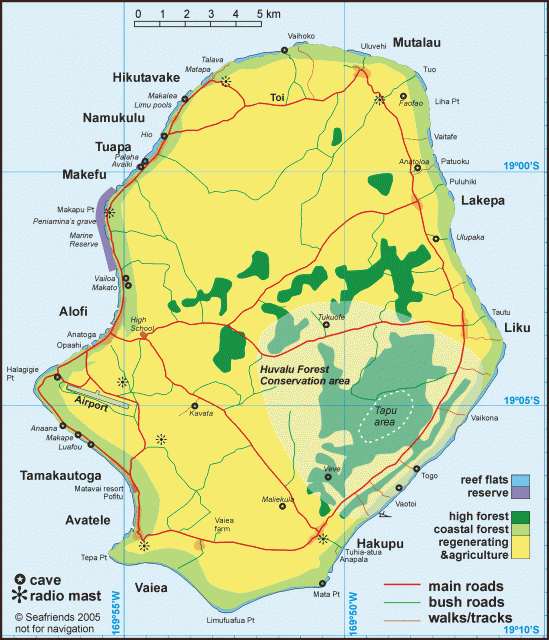Niue
Area 100 square mi (260 square km)
Population 2,145
Capital Alofi
Highest Point unnamed hill near the town of Mutalau 223 ft (68 m)
Lowest Point 0 m
GDP per capita $3,600
Primary Natural Resources agriculture.
ONE OF THE WORLD'S largest coral islands and smallest countries, Niue is about the size of metropolitan District of Columbia in the UNITED STATES and has a population the size of a small town. It has a rugged coastline with high limestone cliffs and a grassy interior plateau. Niue is located 1,491 mi (2,400 km) northeast of NEW ZEALAND, on the eastern side of the INTERNATIONAL DATE LINE and is 11 hours behind Greenwich Mean Time. Most of the population lives in 13 small settlements found along a 41-mi (67-km) road that circles the island.

The island is dotted with limestone caves and is without streams or rivers. Rain water filters through the porous limestone out into the ocean with little silt run-off. This allows the surrounding ocean to be crystal clear with dive visibility often up to 229 ft (70 m). Niue lies in the zone of the southeast tradewinds, giving it a tropical climate with temperatures averaging 75 to 80 degrees F (24 to 27 degrees C) year-round. Niue's isolated location and cultural and linguistic differences have enabled it to maintain independence from other Polynesian islands despite its minuscule size. However, a lack of employment opportunities has caused its population to continue to drop from a peak of 5,200 in 1966 to about 2,100 in 2002 with substantial emigration to New Zealand.
Niuean folklore tells of the first settlement of Niue by forefathers Huanaki and Fao, together with fire gods from Fonuagalo, or the “Hidden Land.” Anthropologists say Polynesians voyaging by outrigger canoe settled on Niue from TONGA, SAMOA, and Pukapuka Island and called the island Motusefua. The English navigator James Cook, sighted Niue in 1774 but was refused landing three times by warriors in canoes. Cook departed but claimed the island for the UNITED KINGDOM and named it Savage Island. Missionaries from the London Missionary Society established Christianity in 1846. Niue chiefs gained British Protectorate status in 1900, but in 1901 Niue was annexed to New Zealand. In 1974, Niue gained independence in free association with New Zealand. The people of Niue enjoy dual citizenship and are bilingual, speaking both Niuean and English.
Niue's economy reflects its geographic isolation, few natural resources, and its tiny population. Most residents are subsistence farmers with some cash crops grown for export. Employers include several small factories that process passion fruit, lime oil, honey and coconut cream. Sales of stamps and commemorative coins to foreign collectors are important sources of revenue. Government expenditures regularly exceed revenues, and the shortfall is made up by grants from New Zealand to pay public employees. Economic aid from New Zealand in 2002 was about $2.6 million.
The official languages are English and Niuean, a Polynesian language closely related to Tongan and Samoan. The predominant religion is Ekalesia Niue (Niuean Church—a Protestant church closely related to the London Missionary Society).